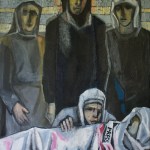
Art is a weapon used by the people in their intellectual and practical struggle to achieve their denied rights. Naturally, this art must be purposeful, organized, clear, and expressive—emerging from the ongoing conflict between the exploiting and the exploited forces. Within it lie the distinct characteristics of committed visual art that serves the struggles of the masses for change and for building a better society.
If we understand that visual art, like all other arts, is existentially bound to the issues of the people—used as both a weapon and a means to achieve their social goals—we must ask: How did the conditions arise that enabled the development of the social and political conception of the mission of visual art in the twentieth century and deepen its meaning?
Modern revolutionary art did not emerge in isolation from social development or from the workers’ revolutions rooted in the labor movements of the past. It grew during the rise of the bourgeoisie and evolved into an armed struggle waged by the working class at the end of the nineteenth century—most notably during the Paris Commune uprising, which marked a new spirit in the life of the working class.
Throughout the nineteenth century, literature and art sought to awaken the human spirit and conscience, portraying a new reality where the individual and collective played a significant role. This role soon evolved into a mission: the necessity for the working class to seize power and infuse literature and art with a revolutionary and humanist spirit. This humanitarian tendency became a driving force behind the later artistic movements.
Creative artists were influenced by the open social atmosphere and the growing capitalist interests that developed in multiple directions—met by corresponding advancements in the forms of workers’ struggle, which culminated in uprisings across Europe. This spirit is evident in Beethoven’s Ninth Symphony, filled with the rhythm of rebellion and optimism, and in Émile Zola’s novel “Germinal,” which depicts the harsh lives of French miners and the suffering of the poor, seeking a solution to their misery.
The artistic and intellectual responses to these struggles took shape in realism and romanticism on one hand, and in idealistic humanism on the other—attempting to ease injustice and promote social harmony. Revolutionary art drew its power and maturity from this democratic, realist, and critical tendency.
As the German critic Ulrich Wehr described, this tendency in art and literature sought to lift oppression from the working people by envisioning an ideal order based on love, brotherhood, and justice within the social context of its time. This progressive movement was a natural result of social evolution.
Art only assumed its revolutionary dimensions after the fall of the Paris Commune and the rise of Marxist thought, which fueled uprisings across Russia, Germany, Hungary, and other industrial European nations. This new phase crystallized revolutionary consciousness and belonging—as seen in the works of Maxim Gorky, the painter George Grosz, the sculptor Constantin Meunier, the printmaker Käthe Kollwitz, and the Hungarian revolutionary poet Sándor Petőfi.
In Petőfi’s poetic call—“Arise and shout, for you people have become like a raging sea embracing the sky”—one feels the revolutionary fervor of the masses. Similarly, in Kollwitz’s art, the suffering of the working class is rendered with devotion and mastery, leaving profound impressions and opening new horizons for modern artists—redefining beauty and ideals in light of human transformation.
This transformation gave the artist a cause. It was not only an internal awakening but also an organized revolutionary movement—embodied in the creation of artists’ unions and collectives committed to spreading political awareness through art.
In Germany, groups such as the Association of Revolutionary Artists, Die Brücke (The Bridge), and Bauhaus united painters, sculptors, and architects. In France and Italy, anti-war and anti-colonial movements took root, while in Japan, the Proletarian Artists’ Movement, and in the United States, the John Reed Clubs, aligned art with the global struggle for liberation and equality under the banner of Marxism-Leninism.
Art for the People
The once-dominant bourgeois notion of “art for art’s sake”—which detached art from social struggles—served only as a tool of deception. But as visual art had long been an instrument of state power, it eventually broke free from absolute subservience. Now, the people themselves could use art and literature in their defense and struggle to build a better society.
As the Soviet thinker Kagan wrote, Marxist-Leninist theory understands the relationship between art and the people as a dialectical unity between scientific objectivity and revolutionary commitment—an active unity aimed at transforming society toward socialism.
The Bolshevik critic Anatoly Lunacharsky wrote:
“The revolution must not only influence art—it needs art. Art is a vital weapon of propaganda. The revolution must give much to the artist, must provide new content. The revolution needs art and the artist, who sooner or later must awaken the latent forces of the people for the sake of the revolution of which he is a part.”
source: Al Ittihad newspaper



















